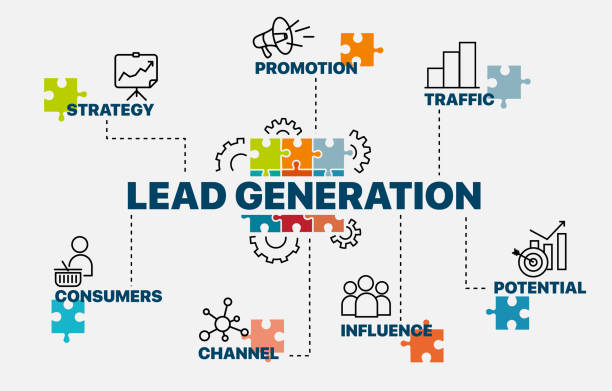Lead Generation: The Ultimate Guide to Converting Interest into Sales
Lead Generation: The Ultimate Guide to Converting Interest into Sales

Competing in the modern digital marketplace, companies have to plan and work steadily. It is important to have strong strategies to change people’s focus into something useful. Lead generation here helps you encourage potential buyers to become real customers of the business.
This guide describes everything about generating leads from B2B leads, using online tactics and discovering useful software and systems to do it.
What is meant by lead generation?
Lead generation involves getting people to notice a product or service to establish a sales funnel. It cuts down the time it takes to convert a customer by approaching the ones who are ready to buy.
Types of Leads Something:
- An interested and active prospect is called a qualified lead.
- Not Qualified Lead – Has shown very little interest and may still be learning.
- Warm Lead – In the middle stage, needs extra care to become ready for selling.
Methods like writing blog posts, preparing resources for download, promoting online marketing lactic email signups and hosting webinars attract people to your brand and gather their contact information. Usually, someone with that initial interest becomes a marketing qualified lead (MQL) and then more activity can transform them into a sales qualified lead (SQL).
Lead Generation Strategies
1. Use tools found in content to fix real issues.
You should start lead generation by publishing content that addresses problems faced by consumers. No matter if you make how-to guides or case studies for customers, illustrate to the audience how your product is useful for them.
2. Rely on lead scoring methods.
A well-made scoring system helps you sort leads by their actions (e.g., downloading content, participating in webinars). By doing this, your team is able to handle the most promising leads first.
3. Generating leads by choosing social media platforms.
Gen Z and Millennials have made social media lead generation a top strategy. Connect with possible leads by using LinkedIn, Facebook and Instagram. Using paid advertising, lead generation and keeping your posts interesting are ways to increase both sign ups and interest.
4. Make your call-to-actions easy for users to spot.
Your CTA needs to be straight forward, clearly explain how someone will benefit and be simple for people to activate. Place sign-up forms on your landing pages, include lots of social proof (e.g., testimonials) and ensure the process is easy.
5. Evaluate and Improve
Test different emails, headings and buttons using A/B testing to learn which get the most engagement. Regularly optimizing your strategies allows you to enhance how you attract leads on the internet.
Lead qualification and nurturing is necessary.
Don’t have your sales team get involved until you have checked a lead’s potential. One frequently used tool is BANT (Budget, Authority, Need, Timing) which shows you how valuable a lead could be.
Using CRM for lead generation makes lead scoring and grading more systematic. Every interaction or behavior is logged by the systems, helping you see how ready and suitable a lead is.
Lead Nurturing ideas
- After lead generation, making sure to nurture them becomes important. Let us look at some effective ways:
- Send out automated emails at regular intervals to build up users’ interest and encourage them to do something.
- Webinars & Virtual Events work well with businesses. Show you are experienced and answer questions as soon as you can.
- Recommendations can be made personally for each customer using data from their activity and CRM records.
- Quizzes and assessments let you qualify leads and engage them at the same time.
- Social Media: Regularly check your messages, post about trends and encourage customers to join in with questions.
The Tools Driving Modern Lead Generation
Software that helps to find lead contacts Using certain tools makes it easier to manage the steps of finding, recording and handling leads. Some of these are landing page builders, email marketing systems and chatbots. Trade systems interact with other systems to maintain smooth flow of data.
How CRM Helps with Lead Generation
A CRM system is necessary to keep track of leads, automatically handle follow-ups and organize communication. Many companies use HubSpot, Salesforce and Zoho CRM to improve how sales and marketing work as a team.
- Changes Impacting How Leads Are Generated in 2025
- AI can show you suggestions for goods, content or discounts based on your previous actions.
- On social media, short films with helpful content are very good at grabbing people’s attention.
- With AI chatbots, real-time support is available 24/7 and information on leads is still collected when the business is closed.
- With Account-Based Marketing (ABM), companies in B2B situations send out messages to high-value customers directly.
Tracking how lead generation efforts are doing
Conversion Rate: The amount of leads who complete tasks we want them to complete.
Cost per Lead (CPL): You get CPL by dividing the total costs by the number of leads.
Lead Quality Score: A rating of how well leads might convert.
ROI: Money obtained from sales divided by the marketing cost.
Tracking: This helps you improve your strategy and use your budget better.
Lead generation Best Practices
- Know exactly who you want to sell to and do some audience segmentation.
- Qualify leads by applying effective scoring and grading.
- Shorten the lead capture form and make sure it’s relevant.
- Ensure your brand style stays the same and deliver what you advertise.
- Frequently check your sales performance and listen to ideas from your sales team.
- Use the CRM to make it easier to keep an eye on leads and communicate with them.
- Pick lead generation software that helps you do what’s necessary for your business.
Final Thoughts
A successful lead generation process also focuses on earning your audience’s trust, providing useful content and maintaining strong relationships. Success in B2B lead generation, improving social media lead generation or using CRM and lead generation software is achieved by effort and ongoing improvement.
FAQS
1.. Why is lead generation important for companies and what is it?
It’s the process of attracting and changing interested people into customers. A business grows by doing this since it lets companies build their sales pipeline and highlight those chances where prospects are likely to become customers.
- What role does CRM play in lead generation?
With a CRM for lead generation, businesses are able to monitor, handle and care for leads much better. It gathers lead details in a single place, takes care of reminders and shows how leads behave which helps marketing and sales teams turn them into customers.
- In what ways are B2B lead generation and B2C lead generation different?
B2B lead generation focuses on other companies and generally requires more time, often using outreach on LinkedIn, hosting webinars and account-based marketing. B2C lead generation is aimed at single customers and generally requires fast actions, using social media advertisements, influencers and email marketing.
- Which approaches help get new leads from the internet?
Multiple online tools can be used to collect and handle leads that arrive online. Examples of these platforms are landing page builders, email marketing software, chatbot applications and CRM systems (such as Salesforce or HubSpot) that help in automatic and personalized communication.
- In which ways do social networks help with lead generation?
Using social media, businesses are able to connect and interact with their intended customers on LinkedIn, Facebook and Instagram. You should use targeted ads, add valuable content and add lead generation forms to obtain user information directly from the platform and increase traffic and turn viewers into customers.

